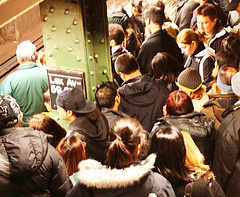Off-Peak Discounts for NYC Transit: An Intriguing Idea
 Photo: cunningsue/Flickr
Photo: cunningsue/FlickrDiscounting off-peak transit service could be a boon to New York City’s transportation and quality of life, so long as revenues can be found to make up for the likely farebox shortfall.
MTA chief Jay Walder floated the idea of off-peak discounts in an interview in today’s New York Times. While Walder didn’t offer quantification, the Balanced Transportation Analyzer software model I’ve developed with Ted Kheel can estimate the effects of time-varied subway fares — not just how ridership might shift from peak to off-peak periods, but indirect impacts such as the shift of auto trips to transit and the resulting changes to car travel speeds.
The results look promising for this prototype fare structure that I tested with the BTA:
- 1/3-off subway fare from 11:00 p.m. to 5:00 a.m.
- 1/6-off subway fare from 5:00 to 7:00 a.m., 10:00 a.m. to 4:00 p.m., and 7:00 to 11:00 p.m.
- 15 percent higher subway fare from 8:00 to 9:00 a.m. and 5:00 to 6:00 p.m. (Although Walder referred only to off-peak discounts, the model suggests that forestalling an increase in ridership during the two peak hours, when the system is strained beyond capacity, could require raising fares at those times.)
- No fare change during the "shoulder" hours of 7:00 to 8:00 a.m., 9:00 to 10:00 a.m., 4:00 to 5:00 p.m., and 6:00 to 7:00 p.m.
- 1/4-off subway fare at all hours on weekends and holidays.
- 1/4-off bus fare at all times (not mentioned by Walder but assumed here to preserve overall fare parity).
Here are the results:
- The average price of a subway ride drops by 23 percent, equivalent to a $210 annual savings for a typical straphanger who takes 12 trains a week.
- Notwithstanding the overall discount, however, peak-hour subway users who could not change their commute times would pay $100 a year more in fares.
- Annual savings of $230 for bus riders, due to the assumed 25 percent drop in bus fares.
- Subway usage increases 3 percent, even as morning and evening peak hour ridership drops by 1 percent and 3 percent, respectively, slightly easing crowding during those critical times.
- Bus usage increases 5 percent.
- 15,000 fewer cars enter the Manhattan CBD on weekdays, raising average speeds there by 2 percent.
- Car and truck drivers save six million hours of travel time worth an estimated $230 million that they now lose to gridlock each year — with a majority of the savings occurring outside the CBD.
- A rise in cycle and pedestrian commuting due to lower traffic, with the resulting increase in physical activity translating into health and longevity benefits worth an additional $116 million a year.
- Fewer crashes and less pollution, with health and related benefits close to $100 million a year.
The downside of this program is an estimated $300 million drop in farebox revenues: $134 million on the subways, $162 million on buses.
The logical place to make up the shortfall, congestion pricing, is a subject Walder will obviously want to avoid until he is on even firmer political footing. The synergies are strong from a technical standpoint, since differential subway pricing would help the subways absorb car drivers whom a cordon toll would induce to switch to transit. The political synergies could be strong as well if differential fares help expand the constituency for congestion pricing.





